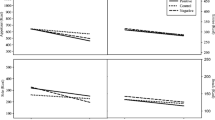Abstract
In the present study, regulation of ice cream intake after a preload was examined in 20 high and 20 low scorers (median split) on subscales of the Restraint Scale (RS) (Herman, Polivy, Pliner, Threshold, & Munic, 1978) and the Dutch Eating Behavior Questionnaire (DEBQ) (van Strien, 1986). For each subscale it was hypothesized that low scorers would regulate their ice cream intake. High scorers on “disinhibitive” scales (i.e., the RS and the DEBQ-emotional and -external subscales) were expected to counterregulate after a preload. In contrast, high scorers on the “inhibitive” DEBQ-restraint scale were expected to regulate their ice cream intake. A robust effect was found: high scorers never regulated ice cream intake after a preload on either the disinhibitive or the inhibitive scales, while low scorers always did. For the RS a significant interaction effect was found [F(1,39)=4.97, p=.03]. None of the other subscales showed interaction effects. The t tests showed that low scorers on all subscales ate significantly less after a preload than without one, while high scorers on all subscales did not differ in intake after a preload or without one. This nonregulation appears to be characteristic of people preoccupied with caloric intake, regardless of the content of the preoccupation.
Similar content being viewed by others
References
Blanchard, A. J., & Frost, R. O. (1983). Two factors of restraint: Concern for dieting and weight fluctuation.Behaviour Research and Therapy, 21(3), 259–267.
Herman, C. P., & Mack, D. (1975). Restrained and unrestrained eating.Journal of Personality, 43, 647–660.
Herman, C. P., & Polivy, J. (1980). Restrained eating. In A. J. Stunkard (Ed.),Obesity (pp. 208–225). Philadelphia: W. B. Saunders.
Herman, C. P., Polivy, J., Pliner, P., Treshold, J., & Munic, D. (1978). Distractability in dieters and nondieters: An alternative view of “externality.”Journal of Personality and Social Psychology, 36, 536–548.
Hibscher, J. A., & Herman, C. P. (1977). Obesity, dieting and the expression of “obese” characteristics.Journal of Comparative and Physiological Psychology, 91(2), 374–380.
Jansen, A., Merckelbach, H., Oosterlaan, J., Tuiten, A., & van den Hout, M. (1988). Cognitions and self-talk during food intake of restrained and unrestrained eaters.Behaviour Research and Therapy 26, 393–398.
Jansen, A., Klaver, J., Merckelbach, H., & van den Hout, M. (1989). Restrained eaters are rapidly habituating sensation seekers.Behaviour Research and Therapy (in press).
Polivy, J. (1976). Perception of calories and regulation of intaken in restrained and unrestrained subjects.Addictive Behaviors, 1, 237–243.
Polivy, J., & Herman, C. P. (1985). Dieting and bingeing. A causal analysis.American Psychologist, 40, 193–201.
Ruderman, A. J. (1985). Restraint, obesity and bulimia.Behaviour Research and Therapy, 23(2), 151–156.
Ruderman, A. J. (1986). Dietary restraint: A theoretical and empirical review.Psychological Bulletin, 99, 247–262.
Ruderman, A. J., & Christensen, H. C. (1983). Restraint theory and its applicability to overweight individuals.Journal of Abnormal Psychology, 92, 210–215.
Ruderman, A. J., & Wilson, G. T. (1979). Weight, restraint, cognitions and counterregulation.Behaviour Research & Therapy, 17, 581–590.
Ruderman, A. J., Belzer, L. J., & Halperin, A. (1985). Restraint, anticipated consumption, and overeating.Journal of Abnormal Psychology, 94, 547–555.
Spencer, J. A., & Fremouw, W. J. (1979). Binge eating as a function of restraint and weight classification.Journal of Abnormal Psychology, 88(3), 262–267.
Stunkard, A. J., & Messick, S. (1985). The three-factor eating questionnaire to measure dietary restraint, disinhibition and hunger.Journal of Psychosomatic Research, 29, 71–83.
van Strien, T. (1986).Eating behaviour, personality traits and body mass. Lisse: Zwets and Zeitlinger.
van Strien, T., Frijters, J., van Staveren, W., Defares, P., & Deurenberg, P. (1986). The predictive validity of the Dutch Restrained Eating Scale.International Journal of Eating Disorders, 5(4), 747–755.
Wardle, J. (1986). The assessment of restrained eating.Behaviour Research and Therapy, 24(2), 213–215.
Wardle, J. (1987a). Eating style: A validation study of the Dutch Behaviour Questionnaire in normal subjects and women with eating disorders.Journal of Psychomatic Research, 31(2), 161–169.
Wardle, J. (1987b). Compulsive eating and dietary restraint.British Journal of Clinical Psychology, 26, 47–55.
Wardle, J., & Beales, S. (1987). Restraint and food intake: An experimental study of eating patterns in the laboratory and in normal life.Behaviour Research and Therapy, 25(3), 179–185.
Author information
Authors and Affiliations
Rights and permissions
About this article
Cite this article
Jansen, A., Oosterlaan, J., Merckelbach, H. et al. Nonregulation of food intake in restrained, emotional, and external eaters. J Psychopathol Behav Assess 10, 345–354 (1988). https://doi.org/10.1007/BF00960627
Accepted:
Issue Date:
DOI: https://doi.org/10.1007/BF00960627




